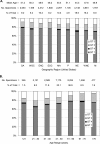Hepatitis C virus genotypes in clinical specimens tested at a national reference testing laboratory in the United States
- PMID: 21613437
- PMCID: PMC3147781
- DOI: 10.1128/JCM.00457-11
Hepatitis C virus genotypes in clinical specimens tested at a national reference testing laboratory in the United States
Abstract
Hepatitis C virus (HCV) genotype (GT) distribution and frequency were studied among 22,407 unique specimens tested at a national reference testing laboratory. Subjects with HCV GT 3 were younger (P < 0.0001) than those with GT 1, 2, or 4, and the regional frequencies of HCV GT 2 and 3 ranged from 19.9% to 29.2%.
Figures

References
-
- Alter M. J. 2002. Prevention of spread of hepatitis C. Hepatology 36:S93–S98 - PubMed
-
- Alter M. J., et al. 1999. The prevalence of hepatitis C virus infection in the United States, 1988 through 1994. N. Engl. J. Med. 341:556–562 - PubMed
-
- Antaki N., et al. 2010. The neglected hepatitis C virus genotypes 4, 5 and 6: an international consensus report. Liver Int. 30:342–355 - PubMed
-
- Armstrong G. L., Alter M. J., McQuillan G. M., Margolis H. S. 2000. The past incidence of hepatitis C virus infection: implications for the future burden of chronic liver disease in the United States. Hepatology 31:777–782 - PubMed
-
- Armstrong G. L., et al. 2006. The prevalence of hepatitis C virus infection in the United States, 1999 through 2002. Ann. Intern. Med. 144:705–714 - PubMed
MeSH terms
LinkOut - more resources
Full Text Sources
Medical
Miscellaneous

